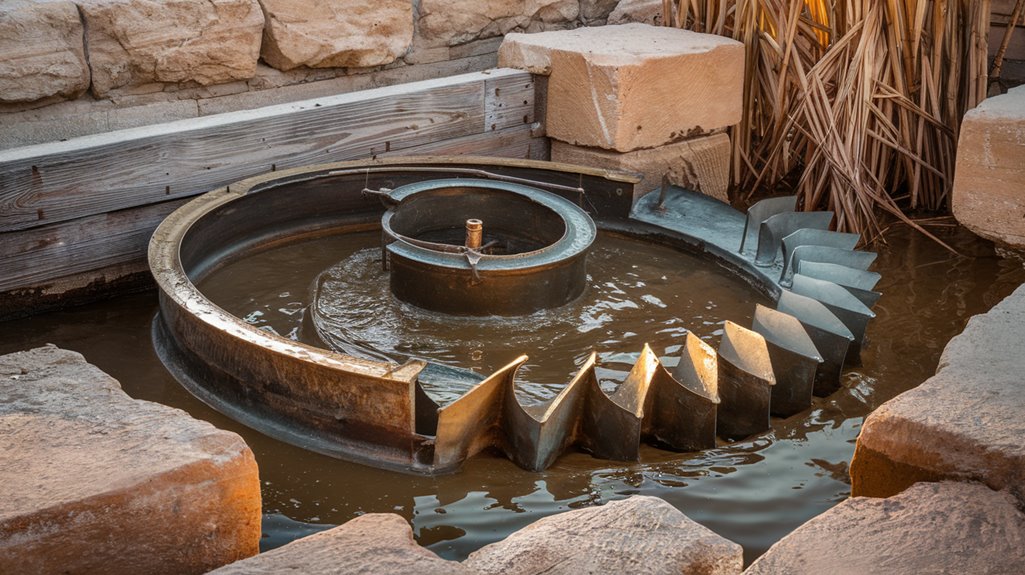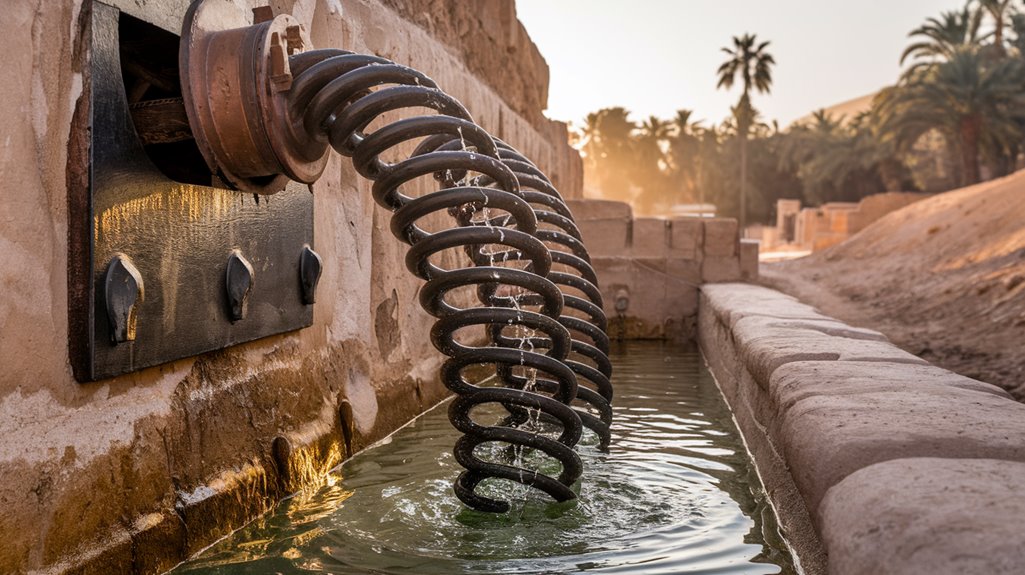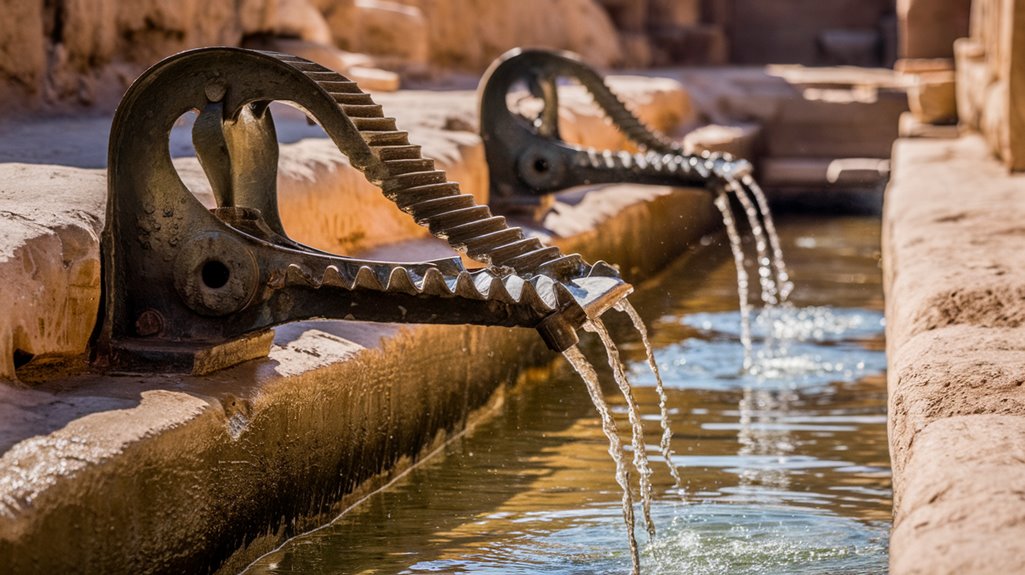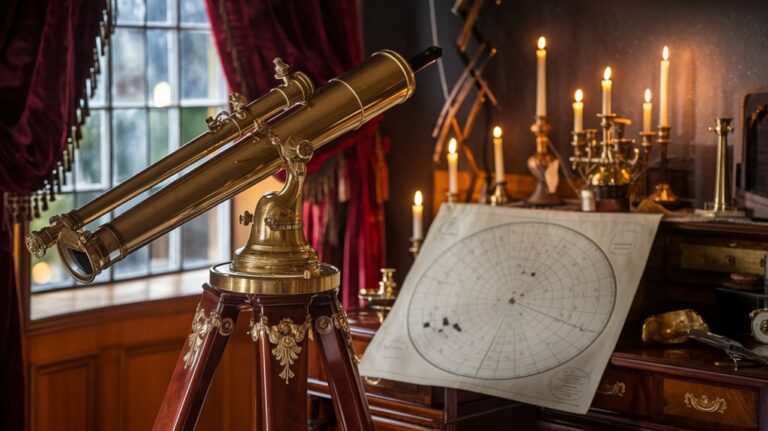Archimedes’ Water Screw: An Ancient Engineering Marvel
Like a brilliant thread woven through time's tapestry, Archimedes' Water Screw stands as one of history's most elegant solutions to a basic human need. You'll find this deceptively simple machine at the crossroads of mathematics and practical engineering, where ancient minds tackled the challenge of lifting water against gravity. While you might think modern technology has left such devices behind, this remarkable invention continues to influence engineering solutions today, and its story holds surprising revelations about human innovation.
The Origins and Historical Development

Three key civilizations played crucial roles in the early development of the water screw: the Assyrians, Egyptians, and Greeks.
You'll find evidence of this ancient innovation dating back to the 7th century BC, when Assyrians and Egyptians first implemented screw pumps for their irrigation techniques. During King Sennacherib's reign (704-681 BC), bronze water screws were being cast, as documented in cuneiform inscriptions. One notable application was its proposed use in maintaining the legendary Hanging Gardens of Babylon.
While the device is commonly known as "Archimedes' screw," its true origins predate his involvement.
When Archimedes visited Egypt around 234 BC, he encountered this existing technology and refined it for Greek applications. Though he didn't invent it, his improvements were so significant that by the 1st century BC, Greek historian Diodorus credited him with its invention. The screw's remarkably simple and efficient design made it a revolutionary tool for lifting water to higher elevations.
Design Principles and Core Mechanics
The genius of the Archimedes screw lies in its elegantly simple design: a helical surface wrapped around a central shaft, enclosed within a hollow pipe. When you rotate the shaft, water gets trapped in the helical pockets and moves upward until it pours out from the top.
Several design enhancement factors determine the screw's performance. You'll get the best results by carefully considering the angle of inclination, pitch of the blades, and rotation speed. Originally, workers would power these devices through manual treading methods until Konrad Kyeser introduced the crank mechanism in 1405. Early applications included removing bilge water from ships, showing the device's practical maritime origins.
The outer radius, inner radius, and number of blades also play essential roles in efficiency factors. Modern engineers use analytical equations to calculate ideal flow rates, typically expressed as ( D_{O} approx eta Q^{3/7} ).
This mathematical precision helps achieve maximum efficiency whether you're using the screw for irrigation, wastewater treatment, or hydroelectric power generation.
Ancient Applications Across Civilizations
While Archimedes' name adorns this remarkable invention, archaeological evidence suggests the water screw's use began centuries before him in ancient Egypt and Mesopotamia.
You'll find traces of its origins dating back to the 7th century BC, where ancient civilizations used it extensively for irrigation techniques and water management.
The device played a vital role across various cultures, from the Neo-Assyrian Empire to the Nile Delta.
In ancient Greece, you'd see it being used not only for irrigation but also for dewatering ships.
The Romans later adapted it for land drainage, particularly in creating polders in the Netherlands. Ancient workers powered these devices through manual labor and animal power to move water efficiently.
What's fascinating is how different societies modified the basic design to suit their needs, whether it was raising water from rivers to agricultural lands or managing water flow in the legendary Hanging Gardens of Babylon. The device's effectiveness came from its helical design that allowed water to be consistently lifted upward through rotation.
The Backflow Challenge and Technical Limitations
Despite its ingenious design, Archimedes' water screw faces considerable challenges with backflow – an inherent hydraulic problem that's plagued water systems since ancient Greece.
When water with higher pressure enters from the top, it can force the screw to rotate backwards, creating serious backflow risks that could contaminate water supplies through unprotected cross-connections. Modern water systems now require cross-connection control programs to prevent these contamination risks.
You'll also find that technical limitations affect the screw's hydraulic efficiency. For optimal performance, these systems typically operate with flow rates between 0.1 and 6 meters per second.
If the length-to-diameter ratio is too small (less than 1.25), performance suffers considerably.
Internal friction between water and moving surfaces, coupled with mechanical losses in bearings and gearboxes, reduces overall efficiency.
While traditional wooden screws operated at around 30% efficiency, modern metal designs achieve 60-70% – though they still contend with back-leakage due to necessary clearance between components.
Modern Adaptations and Engineering Success Stories

Building upon its ancient foundations, Archimedes' water screw has evolved into a versatile engineering solution that's revolutionizing multiple industries today.
You'll find this technology at work in modern agriculture, where it efficiently irrigates dry lands and moves grain in combine harvesters. The device has also found new life in sustainable engineering through small-scale hydroelectric power generation, particularly in low-head installations across North America and the UK. A major new pumping facility using six massive screws demonstrates this ancient technology's critical role in modern flood prevention.
What's truly remarkable is how innovative materials like carbon fiber have transformed this ancient device. Companies can now produce these screws 30% lighter than traditional aluminum versions, significantly improving their operational efficiency.
You'll see these improvements in modern applications, where composite materials enhance durability and reduce maintenance costs. The integration of 3D printing and Light Resin Transfer Molding has made production more efficient, while advanced turbine designs have achieved record-breaking efficiency in hydropower generation.
Global Legacy and Cultural Impact
The genius of Archimedes' water screw transcends both time and cultural boundaries, marking its place as one of history's most enduring engineering marvels. First developed while he studied in Alexandria, the invention demonstrated his early mastery of practical problem-solving.
Its cultural significance extends far beyond ancient Greece, influencing civilizations from Egypt to Mesopotamia and continuing to shape modern engineering practices.
You'll find the technological influence of this remarkable invention in various aspects of contemporary life:
- Educational institutions use it to demonstrate fundamental engineering principles
- Wastewater treatment facilities rely on its efficient design
- Sustainable energy projects adapt its mechanics for hydroelectric power
- Developing nations still employ it for irrigation systems
This ancient device's legacy isn't just about moving water – it represents humanity's innovative spirit and serves as a reflection of the power of simple, effective design in solving complex problems.











